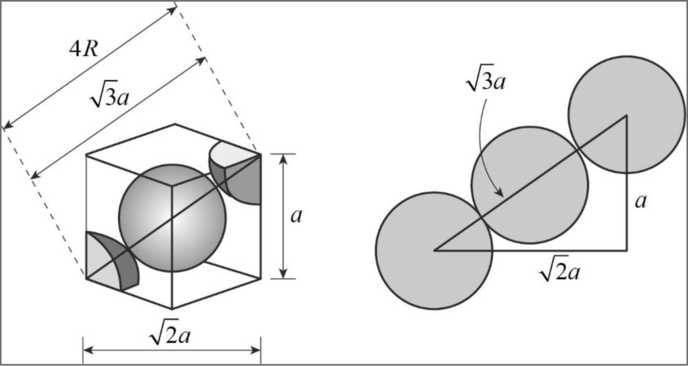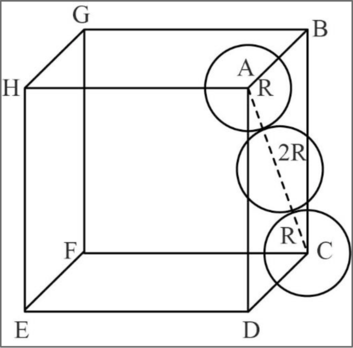
Concept explainers
Interpretation:
The volume of the atoms in bcc and fcc unit cell in comparison to the volume of the unit cell itself has to be calculated. From these data, the fraction of space occupied by atoms in bcc and fcc unit cell has to be calculated.
Concept Introduction:
Bcc unit cell:
Eight atoms occupy the corner position of a cube each contributing
Relationship between unit cell edge length and radius of a unit cell of a bcc arrangement:

Figure 1
Applying Pythagoras theorem, from the diagram we can clearly concluded that
Body diagonal
Fcc unit cell:
Eight atoms occupy the corner position of a cube each contributing
Relationship between unit cell edge length and radius of a unit cell of a fcc arrangement:

Figure 2
In fcc, the corner spheres are in touch with the face centered sphere as shown in the above figure. Hence, the face diagonal
Consider right angled triangle ACD.
Volume of a cubic unit cell:
Volume of cubic unit cell
Volume of a sphere:
Volume of a sphere
Packing fraction:
Packing fraction is the fraction of space occupied by total number of atoms per unit cell.
Mathematically, it can be represented as given below.
Fraction of space occupied by atoms in a unit cell
Where,
Answer to Problem 115QRT
The fraction of space occupied by atoms in bcc and fcc unit cell is
Explanation of Solution
The atoms can be assumed to be spherical in shape with radius
There are two atoms present per one bcc unit cell. The relationship between unit cell edge length and radius of a unit cell of a bcc arrangement is given below.
Now, the total volume of two atoms present in a bcc unit cell can be calculated as given below.
There are four atoms present per one fcc unit cell. The relationship between unit cell edge length and radius of a unit cell of a fcc arrangement is given below.
Now, the total volume of two atoms present in a bcc unit cell can be calculated as given below.
Volume of cubic unit cell ,
Now, the fraction of space occupied by atoms can be calculated as given below.
For bcc unit cell:
Fraction of space occupied by atoms
For fcc unit cell:
Fraction of space occupied by atoms
Therefore, the fraction of space occupied by atoms in bcc and fcc unit cell is
Want to see more full solutions like this?
Chapter 9 Solutions
Chemistry: The Molecular Science
- Provide the complete mechanism for the reactions below. You must include appropriate arrows,intermediates, and formal charges.arrow_forwardIndicate the products obtained by reacting fluorobenzene with a sulfonitric mixture.arrow_forwardIf I have 1-bromopropene, to obtain compound A, I have to add NaOH and another compound. Indicate which compound that would be. C6H5 CH3arrow_forward
- If I have 1-bromopropene and I want to obtain (1,1-dipropoxyethyl)benzene, indicate the compound that I should add in addition to NaOH.arrow_forwardDraw the major product of this reaction. Ignore inorganic byproducts. Ο HSCH2CH2CH2SH, BF3 Select to Draw I Submitarrow_forwardFeedback (7/10) Draw the major product of this reaction. Ignore inorganic byproducts. Assume that the water side product is continuously removed to drive the reaction toward products. Incorrect, 3 attempts remaining Ο (CH3CH2)2NH, TSOH Select to Draw V N. 87% Retryarrow_forward
- If I want to obtain (1,1-dipropoxyethyl)benzene from 1-bromopropene, indicate the product that I have to add in addition to NaOH.arrow_forwardIndicate the products obtained when fluorobenzene reacts with a sulfonitric acid mixture (HNO3 + H2SO4). Indicate the majority if necessary.arrow_forwardIndicate the products obtained when chlorobenzene acid reacts with a sulfonitric acid mixture (HNO3 + H2SO4). Indicate the majority if necessary.arrow_forward
- Indicate the products obtained by reacting benzenesulfonic acid with a sulfonitric acid mixture (HNO3 + H2SO4). Indicate the majority if necessary.arrow_forwardIndicate the products obtained by reacting ethylbenzene with a sulfonitric acid mixture (HNO3 + H2SO4). Indicate the majority if necessary.arrow_forwardIndicate the products obtained when tert-butylbenzene reacts with a sulfonitric acid mixture (HNO3 + H2SO4). Indicate the majority if necessary.arrow_forward
 Chemistry: The Molecular ScienceChemistryISBN:9781285199047Author:John W. Moore, Conrad L. StanitskiPublisher:Cengage Learning
Chemistry: The Molecular ScienceChemistryISBN:9781285199047Author:John W. Moore, Conrad L. StanitskiPublisher:Cengage Learning Principles of Modern ChemistryChemistryISBN:9781305079113Author:David W. Oxtoby, H. Pat Gillis, Laurie J. ButlerPublisher:Cengage Learning
Principles of Modern ChemistryChemistryISBN:9781305079113Author:David W. Oxtoby, H. Pat Gillis, Laurie J. ButlerPublisher:Cengage Learning Chemistry: Principles and PracticeChemistryISBN:9780534420123Author:Daniel L. Reger, Scott R. Goode, David W. Ball, Edward MercerPublisher:Cengage Learning
Chemistry: Principles and PracticeChemistryISBN:9780534420123Author:Daniel L. Reger, Scott R. Goode, David W. Ball, Edward MercerPublisher:Cengage Learning Physical ChemistryChemistryISBN:9781133958437Author:Ball, David W. (david Warren), BAER, TomasPublisher:Wadsworth Cengage Learning,
Physical ChemistryChemistryISBN:9781133958437Author:Ball, David W. (david Warren), BAER, TomasPublisher:Wadsworth Cengage Learning, ChemistryChemistryISBN:9781305957404Author:Steven S. Zumdahl, Susan A. Zumdahl, Donald J. DeCostePublisher:Cengage Learning
ChemistryChemistryISBN:9781305957404Author:Steven S. Zumdahl, Susan A. Zumdahl, Donald J. DeCostePublisher:Cengage Learning Chemistry: An Atoms First ApproachChemistryISBN:9781305079243Author:Steven S. Zumdahl, Susan A. ZumdahlPublisher:Cengage Learning
Chemistry: An Atoms First ApproachChemistryISBN:9781305079243Author:Steven S. Zumdahl, Susan A. ZumdahlPublisher:Cengage Learning





